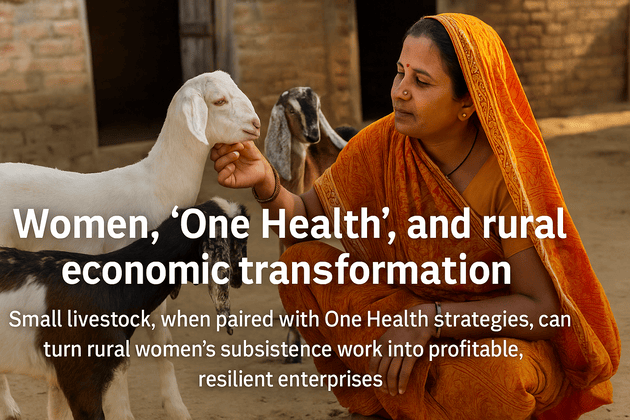
Women, ‘One Health’, and rural economic transformation


Small livestock, when paired with One Health strategies, can turn rural women’s subsistence work into profitable, resilient enterprises
In India’s rapidly evolving rural economy, millions of women remain active yet largely invisible in economic terms. The Periodic Labour Force Survey (PLFS) 2022–23 records a rural female labour force participation rate of 53%, yet much of this work—such as livestock care, water collection, caregiving, and small-scale farming—is informal and unpaid. Despite their dedication, rural women are seldom recognised as economic contributors.
Goat farming as a pathway to empowerment

This contrast presents a key opportunity: small ruminant farming, particularly rearing goats and sheep, can serve as a driver for economic empowerment, improved public health, and environmental sustainability. This livestock activity is especially suitable for women from landless, low-income, and marginalised groups. Goats require little maintenance, breed quickly, need minimal space, and provide consistent income through milk, manure, meat, and offspring.
A woman caring for four to five goats could earn ₹60,000–₹80,000 annually, or up to ₹1.1 lakh through meat sales and value addition, equating to 150–200% of the rural poverty line income in India. The true significance of goat farming lies in its ability to stimulate transformative subsistence entrepreneurship—a process where entrepreneurs move beyond mere survival to expand their ventures and improve their well-being. This shift is not spontaneous; it relies on two key factors—entrepreneurial intent and environmental triggers.
Enablers of transformative entrepreneurship

For rural women, triggers such as access to credit, training, veterinary services, market links, and collective support help shift their mindset from mere maintenance to aspiration. Public schemes and grassroots innovations serve as vital catalysts. For example, the National Livestock Mission (NLM) promotes breed improvement, fodder development, and entrepreneurship, with a particular emphasis on women-led ventures. The Kisan Credit Card (KCC) now includes animal husbandry, allowing women to access affordable loans for feed, healthcare, and working capital. Although the Rashtriya Gokul Mission mainly targets indigenous cattle, it also strengthens veterinary infrastructure, providing indirect benefits to small ruminants.
Equally significant are Self-Help Groups (SHGs), which provide access to microcredit and offer training in animal husbandry, bookkeeping, entrepreneurship, and digital skills. As women collaborate by pooling resources, sharing knowledge, and accessing credit collectively, they become better equipped to transition from basic goat rearing to growth-orientated businesses.
One Health: linking livelihoods and well-being

However, they also face new health and environmental dangers, underscoring the importance of the One Health approach. This strategy emphasises the interconnections between human, animal, and ecological health, particularly in rural areas where women often live in close proximity to livestock. Species such as goats and sheep can carry zoonotic diseases, including brucellosis, Q fever, and anthrax, which pose a threat to both humans and animals. Women, often responsible for birthing, feeding, and milking, are typically the first to be exposed but may lack knowledge or access to veterinary care.
The risk increases with the growing number of pets, such as dogs and cats, in rural and semi-urban regions, leading to cross-species disease transmission. For example, dogs can transmit Echinococcus granulosus (hydatid disease) to goats, reducing their productivity, and ticks facilitate the transmission of vector-borne illnesses such as anaplasmosis and theileriosis.
To mitigate these risks effectively, comprehensive health and sanitation programmes targeting women are crucial. India’s Livestock Health and Disease Control (LHDC) scheme and the National Animal Disease Control Programme (NADCP) aim to control foot-and-mouth disease and brucellosis through vaccination and surveillance. Their effectiveness depends on integrating these efforts with clean water, sanitation, and behaviour change initiatives. Partnering with programmes such as Swachh Bharat Abhiyan and Jal Jeevan Mission is essential to link animal health with human hygiene and ecosystem preservation within the One Health framework.

Community-based models play a key role in bridging implementation gaps. For example, in Maharashtra, the Mann Deshi Foundation’s Goat Sakhi programme trains rural women as para-veterinarians and micro-entrepreneurs, providing livestock treatment, selling supplements, and educating communities on disease prevention, nutrition, and hygiene. Mann Deshi also runs diagnostic labs and mobile veterinary services for remote areas.
From a single goat to lasting change
These interventions, often called environmental or policy triggers, are vital because, according to the 20th Livestock Census (2019), India has 148.9 million goats and 74.3 million sheep, ranking second globally for goats and among the top five for sheep. India is the largest producer of goat milk, but productivity is low—about 180 kg per goat annually (0.48 kg/day)—compared to 687 kg in France and 798 kg in the Netherlands. For meat, Indian goats produce around 8–12 kg of carcass weight, whereas breeds in countries such as the USA and Australia yield 18–22 kg, highlighting a significant productivity gap.

Beginning with a single goat through a government scheme or SHG loan, a woman can gradually scale into a thriving enterprise by expanding herds, reinvesting earnings, and diversifying into value-added activities such as feed supply, veterinary services, and dairy processing. The impact extends beyond livelihood improvement; it marks a significant change in women’s social and economic roles, fostering transformative entrepreneurship.
This aligns with E.F. Schumacher’s timeless idea from ‘Small Is Beautiful’: actual development is not just about scale but about humane, decentralised solutions rooted in dignity. Goat farming exemplifies this—small in size but significant in impact—empowering women to remain within their social contexts while challenging power structures, accessing markets, and building resilient futures.
No Techcircle journalist was involved in the creation/production of this content.


Ekaa Desai and Ashish Desai
Ashish Desai is an Associate Professor of Information Management and Analytics at the S.P. Jain Institute of Management and Research (SPJIMR), and Ekaa Desai is a BVSC & AH student at Mumbai Veterinary College.
